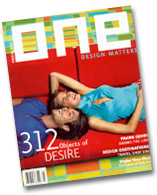
By comparison to Wallpaper*, *Surface, and Nest, Dwell and One, the brand-new publications under review here, seem like oxymorons: trendy magazines without attitude. Both are instructive. Neither is ironic. Both are based in San Francisco. Dwell is a magazine devoted to high modernism in residential design that exhibits all the seriousness of an architecture graduate student--and thankfully, none of the lingo. The idea here is that you, too, are entitled to a well thought-through and original home, even if you're not a trust-fund type and your interior decor would not normally show up in the pages of a shelter book. One is a frankly commercial product, but it has a mission, too, which is to explain the elements of style to the novice. The writing in both is clear and plain, and One has a shopping feature in the back, which turned out to be a handy holiday gift guide.
How did readers get so lucky? The answer is obvious in the case of Dwell. It is the dream child of a media outsider: a woman who, after she found that she couldn't express her ideas for a new house to architects in words they'd pay attention to, went to architecture school. Dwell's editor, former New York magazine design and architecture writer Karrie Jacobs, does a good job of recreating her boss' sense that house design is an occasion for self-discovery. Each house is a sort of tell-all. The subject of Dwell's second issue, called "There is Too a There There," is radical single-family dwellings in parts of the country not usually thought of as cutting-edge--outside Milwaukee or in Baton Rouge, La., or in Louisville, Ky. The write-up on a stripped-down Frank Lloyd Wright-like house built outside Milwaukee for a retired narcotics detective and his wife, a forensic chemist, takes you step by step through their first inklings, the design process, and the construction phase. There's the circuitous path that the couple traveled before ending up in an architect's office--they hated the banal subdivision-style dwelling that local contractors wanted to build for them--and their difficulties getting financing to pay for the architects, deemed by the bank to be an unnecessary luxury. Then we read about the architects' response to a beautiful rural plot of land, and their efforts to design something suitable, and see the finished product. All this is interesting if you've ever yearned to build your own house, possibly not if you haven't.
Another rags-to-riches story involves a house in Baton Rouge--a typical Louisianan shotgun shack transformed into a bright if small loftlike home by two recent graduates of the Columbia University architecture program. The key to creating a flow of light between the long, narrow, undifferentiated rooms is walls that aren't walls: five black louvered doors in the middle of the house that provide privacy but let sunshine through and the beams of an old wall from which the filling has been removed. The rest is cleverly placed windows, furniture, and finishes. The house has a warm Southern feel with a nice aura of clutterlessness, and it's being viewed as a model for future renovations of similar shacks in the poorer parts of downtown Baton Rouge.
House spreads aside, the magazine is devoted to identifying typical architectural problems and solving them. What's the best kind of storage unit? How do you provide security for a ground-floor window in a lousy part of town without making yourself feel caged in? The back of the magazine gives itself over to more intellectual concerns--in the second issue, the debate over the New Urbanism, a movement aimed at recreating a small-town feel that is usually identified with cute little houses in Seaside, Fla. (immortalized in the movie The Truman Show). Why are New Urbanists so hostile to modernism? asks Dwell. They're not, say the New Urbanists. "That's disingenuous," replies Dwell. "New Urbanists believe, perhaps not fully aware of the irony, that the best places to live in America were the small towns that Americans in great numbers fled during the first half of the 20th century seeking to escape their commanding power to mold residents in exactly the manner that New Urbanists expect that their new towns will."

You won't find such pointed commentary in One, which lacks the quiet evangelical fervor of Dwell. But One has potential nonetheless, and possibly more financial staying power. (It's backed by the former publisher of Wired.) Though irritatingly in the thrall of the idea of the celebrity designer, One is pitched at the right level for amateurs such as Culturebox. For instance, she had never heard of Karim Rashid, a star of the industrial design world profiled in One's premiere issue, even though insiders assure her that he's old, old news. And indeed, if you ignore the yawn-provoking conventions of profile journalism ("After graduating from Carleton University in Ottawa, Canada, he pursued graduate studies in Naplies, Italy, before moving on to Milan...") and the self-aggrandizing quotes, Rashid turns out to be a man with ideas: instruction-free plug-and-play TVs and stereos, textured plastic perfume bottles, Armani stores with little furniture but lots of transparent panels displaying videos of clothes. "The idea is that there would be very little clothing in the space and more emphasis on the digital ordering and the experience of being there," says Rashid. (Armani demurred to build the stores and canceled his contract with the designer.)
One is not quite the magazine people once hoped it would be since its founding editor was supposed to be Chee Pearlman, until recently the editor of the best design magazine in America, I.D. Somewhere between the conception and the execution fell the shadow of editorial differences, and the editor is now Stacy Morrison, formerly of Modern Bride. Perhaps the gee-whiz quality of the prose owes something to that replacement, but enthusiasm is never oppressive (cynicism is) and will probably fade after a while. Let the Yohji Yanamoto-clad sneer at the articles on Frank Gehry's doodles and the OXO revolution--OXO being a company that makes clever and handsome kitchen devices that has been much written about, including in Slate. Culturebox likes the idea of being able to pick up, every so often, a design magazine that will tell her everything the know-it-alls already know.